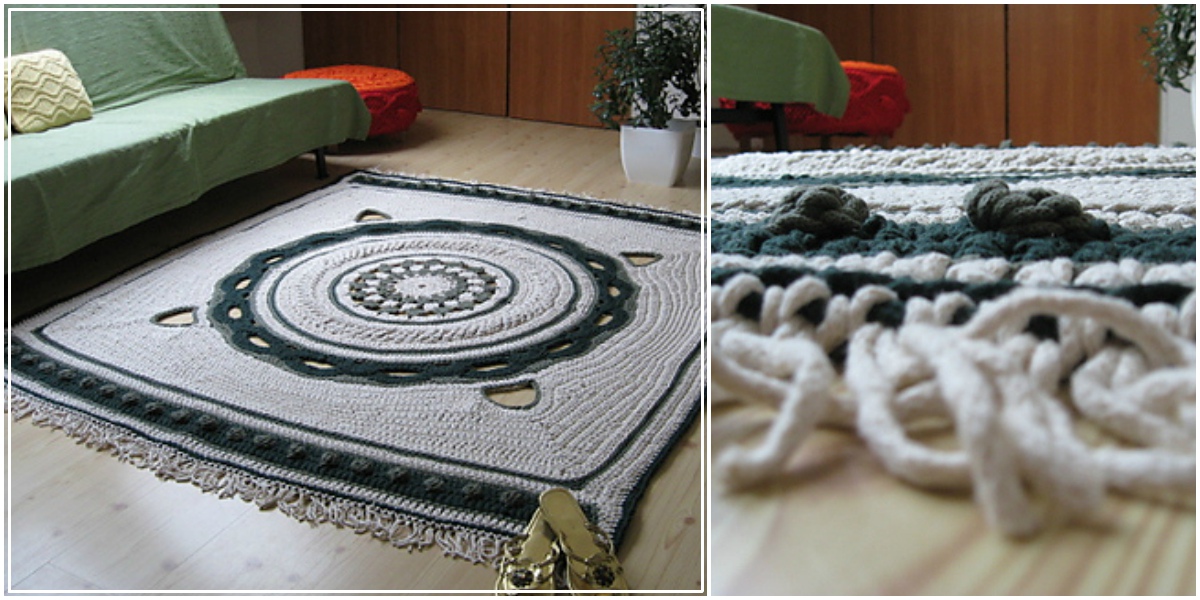White-Green Mandala Crochet Carpet

A White-Green Mandala Crochet Carpet adds a touch of elegance, serenity, and beauty to any space. The intricate design, combined with the soothing white and green color palette, creates a mesmerizing focal point in any room.
Perfect for adding style to your living room, bedroom, or meditation space, this crochet carpet serves as both a practical item and a work of art.
In this guide, we’ll dive into how to create your very own mandala carpet, share design ideas, customization tips, and answer common questions.
Why Crochet a White-Green Mandala Carpet?
A mandala carpet is much more than a floor covering. Its beauty and complexity bring peace and visual interest to any space. Here are some reasons why creating one is worth the effort:
- Meditative quality: The repetitive crochet stitches and round shape make it a relaxing and almost meditative project.
- Versatile decor: Works well as a decorative carpet, wall hanging, or even a centerpiece on large tables.
- Personalized touch: The color combination and design make it a unique reflection of your style.
- Therapeutic craft: Mandala crocheting is known for its calming effect and can be a great stress-relief activity.

You will require three shades of cotton twine:
- 1500 meters of regular/undyed twine
- 350 meters of olive/khaki twine
- 450 meters of dim green twine

Furthermore, a 9 mm knit snare (I think its M/N in the US). It took me around 15 hours to finish the work. The last size was 160 x 200 cm without the periphery.
Step 1: Start with the Foundation Circle
Begin the mandala with a magic ring, which will serve as the center of your carpet.
- Magic Ring: Create a magic ring with white yarn.
- Round 1: Ch 2 (counts as first dc), work 11 dc into the ring. Sl st to the top of the starting ch 2 to join. (12 sts total).
Tip: Pull the ring tight to close any gaps in the center.
Step 2: Build the Mandala with Color Changes
The mandala effect is achieved by alternating rounds of white and green. Each round typically increases to keep the carpet flat and circular.
- Round 2 (Green): Ch 2, dc in the same st, 2 dc in each st around. Join with sl st. (24 sts).
- Round 3 (White): Ch 2, dc in the same st, 1 dc, 2 dc in next st around. Join with sl st. (36 sts).
- Round 4 (Green): Ch 2, dc in the same st, 2 dc, 2 dc in next st around. Join with sl st. (48 sts).
Continue alternating colors and adding one more dc between increases in each new round to create a smooth, expanding circle. For instance:
- Round 5 (White): 3 dc, 2 dc in next st
- Round 6 (Green): 4 dc, 2 dc in next st
Repeat these rounds, following the increase pattern until your mandala reaches the desired size.
Step 3: Add Texture and Pattern Variations
Enhance your mandala with textured stitches like puff stitches, clusters, or shell stitches to add dimension.
- Textured Round (White): 3 dc in next st, skip 1 st, sc in next st for a shell effect.
- Cluster Round (Green): Work 3 dc together in one st, sc in next st, repeat.
Step 4: Finish with a Decorative Border
A well-chosen border completes the look of your mandala carpet.
- Border Round (White): Work a picot or scallop edge for a decorative finish.
- Scallop: 5 dc in same st, skip 2 sts, sc in next st, repeat.
- Picot: sc, ch 3, sl st into first ch, sc in next st, repeat around
A White-Green Mandala Crochet Carpet is a beautiful addition to any space, offering both functionality and artistry. From color choices to texture enhancements, the options are endless when creating your unique mandala.
Take your time, experiment with stitches and colors, and enjoy the calming, meditative process of crocheting this intricate design. With patience and creativity, your mandala carpet will become a cherished item that brings style and warmth to your home.
CHECK MORE CROCHET PATTERNS